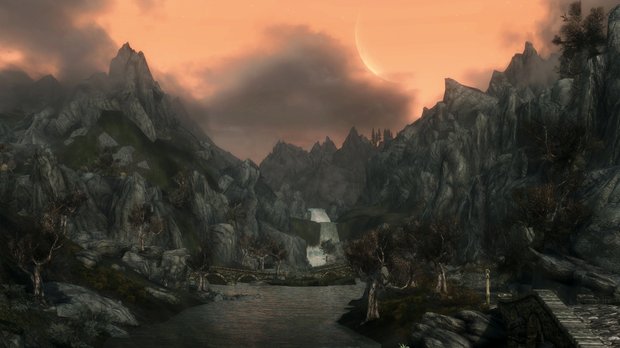Why Skyrims most barren environment makes for a bountiful world
Like most nations in the real world, Skyrim is anything but homogenous. It has no one definitive landscape or city. It’s a sum of disparate parts stitched together into a rich geographical tapestry. While the concept of variety in most open-world games translates into a series of playgrounds – jungle area, ice area, desert area and so on – Bethesda has proven itself a master of nuanced worldbuilding. In Skyrim, as with previous Elder Scrolls titles, the developer has paid as much attention to how the parts fit together as to the parts themselves.

No region exemplifies this tendency more than The Reach, a hold to the west. Wedged between two mountain ranges, frequently shrouded by claustrophobic fog, strangled by spindly plants and occupied by a resentful indigenous race, The Reach is arguably the most distinct locale in Skyrim. Yet it is also a microcosm of Skyrim’s identity as a nation – held together by the very tensions that threaten to destroy it.
First impressions matter, and there are many first paths a new player can take into Skyrim’s expansive world. But few will find themselves venturing to The Reach before they experience Skyrim’s other regions. The nation’s contours bend the player away from its murky paths. None of its landmarks stand out on a distant horizon, hidden as they are behind the mountains.
Only two paths cleave between the mountains to connect The Reach with the rest of Skyrim. Each leaves the main highway between the cities of Whiterun and Solitude to spiral up and around mountain passes, and then drops the player into The Reach’s north or south. These paths are easily overlooked; they don’t go anywhere else. Skyrim’s helpful street signs, indicating cities across the country, point off in all other directions at these intersections, with only the one lonely arrow directing you into The Reach. The Reach is a dead end. You will not stumble upon The Reach while trying to go somewhere else.

The Reach possesses its own geography, its own politics, and its own cultures. Walking down either path, the shift from the rest of the Skyrim into The Reach is stark. The brownish grass gives way to solid stone. The green trees and flowers make way for the skeletal grey juniper trees, their roots clinging to the rock with eerie desperation. As the paths descend down from the grasslands into The Reach proper, a thick fog typically descends on all but the most fair-weather days.
There is a suffocating dankness to The Reach that extends from the sky overhead down to the earth underfoot. The river that carves a path through the region is a murkier colour than the waterways elsewhere in the country, as though the fog has polluted the water itself. But it is the stone that rises up on either side of the path that most vividly distinguishes The Reach from the rest of Skyrim. These aren’t the sweeping mountains of the rest of the country. These are abrupt, jagged walls that fence you in and push you into the region’s serpentine belly. As you follow the region’s few paths, the open blue sky and its distant vistas are consumed by the towering rock, reduced to a dark grey slither far above you.
Everything feels alien in The Reach, not least of all the indigenous Forsworn people. Their camps are easily distinguishable from any other race. Various animal heads and body parts decorate their tents. Native monsters that would cheerfully maul any other stand by their side, as if to tell you that the Forsworn are a natural part of this place. Indeed, the Forsworn claim The Reach as their homeland. While the Nords fancy themselves oppressed throughout Skyrim, subjugated by an expansionist Empire, here they are most certainly the oppressors.
Weekly digests, tales from the communities you love, and more

The Reach’s Nords live in the city of Markarth, which almost cowers beneath the foothills of the area’s tallest mountains. Unsurprisingly, Markarth is unlike any other city in Skyrim. Built within the ruins of an ancient Dwemer city, Markarth boasts houses carved into the stone itself, one atop the other. The Jarl’s palace is a towering Dwemer hall, too big for the Nords’ torches to light effectively. The city feels like a younger brother in hand-me-down clothes. Everything is slightly too large, reappropriated and not quite right.
The Reach exemplifies the complicated politics that pervade all of Skyrim. While the Nords and the Empire both call the nation theirs, the Forsworn make for a sticky complication. Markarth’s bones, meanwhile, are a constant reminder that the Dwemer and the Snow Elves staked claim to the land long before any human race. By complicating our concept of just what Skyrim ‘is’, The Reach reminds us that for every group’s supposedly straightforward right to own the land, the reality is far more complex.
Ultimately, without its variety of peoples, Skyrim would lack its rich identity. Nations aren’t purely singular entities so much as amalgamations of contesting identities held in constant tension. It is the relations between the parts that construct a nation’s identity, not the parts themselves.

In this way, The Reach makes Skyrim feel more complete, more convincing. Pushed to the edge of the game’s world, The Reach stands out most for how it is unlike the rest of the nation. But instead of jarring, its different cultures and geography contribute something vital to making Skyrim’s virtual world truly feel like a living nation – a mottled patchwork that forms a beautiful, improbable whole.
Read more from Edge here. Or take advantage of our subscription offers for print and digital editions.
Edge magazine was launched in 1993 with a mission to dig deep into the inner workings of the international videogame industry, quickly building a reputation for next-level analysis, features, interviews and reviews that holds fast nearly 30 years on.



